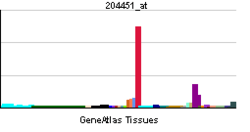FZD1
| View/Edit Human | View/Edit Mouse |
Frizzled-1 is a protein that in humans is encoded by the FZD1 gene.[3][4]
Function
Members of the 'frizzled' gene family encode 7-transmembrane domain proteins that are receptors for Wnt signaling proteins. The FZD1 protein contains a signal peptide, a cysteine-rich domain in the N-terminal extracellular region, 7 transmembrane domains, and a C-terminal PDZ domain-binding motif. The FZD1 transcript is expressed in various tissues.[4]
See also
References
- ↑ "Human PubMed Reference:".
- ↑ "Mouse PubMed Reference:".
- ↑ Sagara N, Toda G, Hirai M, Terada M, Katoh M (Nov 1998). "Molecular cloning, differential expression, and chromosomal localization of human frizzled-1, frizzled-2, and frizzled-7". Biochemical and Biophysical Research Communications. 252 (1): 117–22. doi:10.1006/bbrc.1998.9607. PMID 9813155.
- 1 2 "Entrez Gene: FZD1 frizzled homolog 1 (Drosophila)".
Further reading
- Tanaka S, Akiyoshi T, Mori M, Wands JR, Sugimachi K (Aug 1998). "A novel frizzled gene identified in human esophageal carcinoma mediates APC/beta-catenin signals". Proceedings of the National Academy of Sciences of the United States of America. 95 (17): 10164–9. doi:10.1073/pnas.95.17.10164. PMC 21479
 . PMID 9707618.
. PMID 9707618. - Gazit A, Yaniv A, Bafico A, Pramila T, Igarashi M, Kitajewski J, Aaronson SA (Oct 1999). "Human frizzled 1 interacts with transforming Wnts to transduce a TCF dependent transcriptional response". Oncogene. 18 (44): 5959–66. doi:10.1038/sj.onc.1202985. PMID 10557084.
- DeCostanzo AJ, Huang XP, Wang HY, Malbon CC (May 2002). "The Frizzled-1/(beta(2))-adrenergic receptor chimera: pharmacological properties of a unique G protein-linked receptor". Naunyn-Schmiedeberg's Archives of Pharmacology. 365 (5): 341–8. doi:10.1007/s00210-002-0540-3. PMID 12012019.
- Hering H, Sheng M (Jun 2002). "Direct interaction of Frizzled-1, -2, -4, and -7 with PDZ domains of PSD-95". FEBS Letters. 521 (1-3): 185–9. doi:10.1016/S0014-5793(02)02831-4. PMID 12067714.
- Zilberberg A, Yaniv A, Gazit A (Apr 2004). "The low density lipoprotein receptor-1, LRP1, interacts with the human frizzled-1 (HFz1) and down-regulates the canonical Wnt signaling pathway". The Journal of Biological Chemistry. 279 (17): 17535–42. doi:10.1074/jbc.M311292200. PMID 14739301.
- Wu J, Klein TJ, Mlodzik M (Jul 2004). "Subcellular localization of frizzled receptors, mediated by their cytoplasmic tails, regulates signaling pathway specificity". PLoS Biology. 2 (7): E158. doi:10.1371/journal.pbio.0020158. PMC 449784
 . PMID 15252441.
. PMID 15252441. 
- Omoto S, Hayashi T, Kitahara K, Takeuchi T, Ueoka Y (Jun 2004). "Autosomal dominant familial exudative vitreoretinopathy in two Japanese families with FZD4 mutations (H69Y and C181R)". Ophthalmic Genetics. 25 (2): 81–90. doi:10.1080/13816810490514270. PMID 15370539.
- Yang L, Yamasaki K, Shirakata Y, Dai X, Tokumaru S, Yahata Y, Tohyama M, Hanakawa Y, Sayama K, Hashimoto K (May 2006). "Bone morphogenetic protein-2 modulates Wnt and frizzled expression and enhances the canonical pathway of Wnt signaling in normal keratinocytes". Journal of Dermatological Science. 42 (2): 111–9. doi:10.1016/j.jdermsci.2005.12.011. PMID 16442268.
External links
- "Frizzled Receptors: FZD1". IUPHAR Database of Receptors and Ion Channels. International Union of Basic and Clinical Pharmacology.
This article incorporates text from the United States National Library of Medicine, which is in the public domain.
This article is issued from Wikipedia - version of the 5/20/2016. The text is available under the Creative Commons Attribution/Share Alike but additional terms may apply for the media files.

